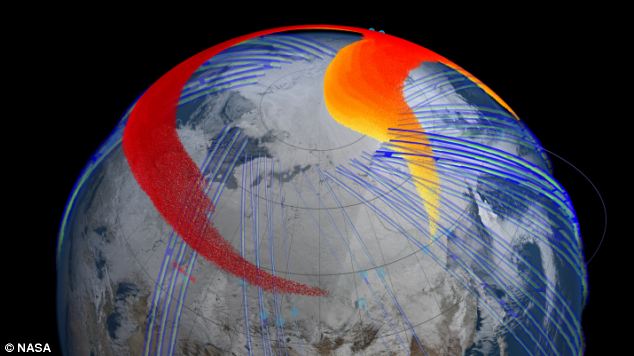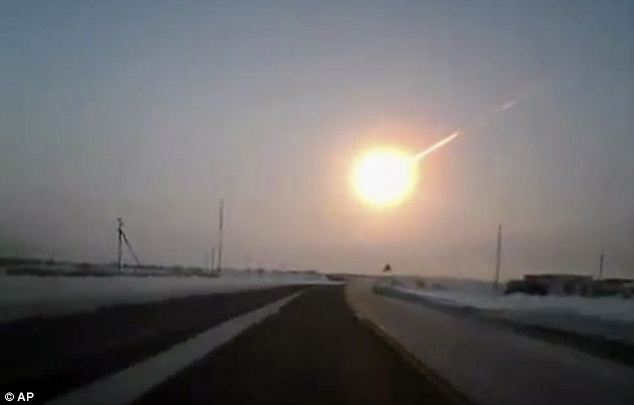NASA satellites made the unprecedented measurements of the meteor which is thought to have released 30 times more energy than the atomic bomb that destroyed Hiroshima.
The meteor fireball measuring 18 meters across and weighing 11,000 metric tons, screamed into Earth's atmosphere at 41,600 mph.

Burning from the friction with Earth's thin air, the space rock exploded 14.5 miles (23.3km) above the Russian town Chelyabinsk.
For comparison, the meteor that triggered mass extinctions, including the dinosaurs, measured about 10 kilometres across and released about 1 billion times the energy of the atom bomb.
Some of the surviving pieces of the Chelyabinsk bolide fell to the ground. But the explosion also deposited hundreds of tons of dust up in the stratosphere forming a thin but cohesive and persistent dust belt.
We wanted to know if our satellite could detect the meteor dust,' said atmospheric physicist Nick Gorkavyi of Nasa's Goddard Space Flight Center.
'Indeed, we saw the formation of a new dust belt in Earth's stratosphere, and achieved the first space-based observation of the long-term evolution of a bolide plume.'
Gorkavyi and colleagues combined a series of satellite measurements with atmospheric models to simulate how the plume from the bolide explosion evolved as the stratospheric jet stream carried it around the Northern Hemisphere.
About 3.5 hours after the initial explosion, the Ozone Mapping Profiling Suite on the Nasa-NOAA Suomi National Polar-orbiting Partnership satellite detected the plume high in the atmosphere at an altitude of about 25 miles (40 kilometers), moving east at about 190 mph.

Larger, heavier particles began to lose altitude and speed, while their smaller, lighter counterparts stayed aloft and retained speed - consistent with wind speed variations at the different altitudes.
Just four days after the explosion, the faster, higher portion of the plume had snaked its way entirely around the Northern Hemisphere and back to Chelyabinsk.
At least three months later, a detectable belt of bolide dust was still present around the planet.
Spanish astrophysicists analysed fragments of the meteor that were scattered across the Russian town of Chelyabinsk, where the meteor landed, and claim it came from the large Apollo asteroid that regularly crosses passed Earth as it orbits the sun.
They added that the piece may have broken off because of the stress caused by the gravitaional pull of the planets and the sun, or could have been caused by the asteroid hitting into something else during its orbit.
Over 1,000 people were injured by the exploding rock and scientists managed to recover more than 50 tiny fragments of the meteor, allowing them to study its contents and origin.
As it raced through the sky, the 50-foot wide chunk of space rock compressed the air ahead of it, creating the enormous temperatures that meant it exploded in a fireball.
Although some debris fell to earth, 'whipping up a pillar of ice, water and steam' and creating a 20-foot-wide crater, the damage in nearby towns was actually caused by shockwaves created by the meteor breaking the sound barrier and then exploding.
'Of course, the Chelyabinsk bolide is much smaller than the "dinosaurs killer," and this is good,' said Gorkavyi.
'We have the unique opportunity to safely study a potentially very dangerous type of event.'
Collectors from around the world will be keen to get hold of a piece of the meteor. Film director Steven Spielberg is a noted collector. In October a 9in piece of the Seymchan meteorite found in Siberia in 1960 sold in New York for $43,750 (£28,200).
Astronomers have also revealed that the meteor could have hit UK cities if it had hit at a slightly different time of day.



in the same area of the planet that is experiencing unusually cool weather for the month of August.